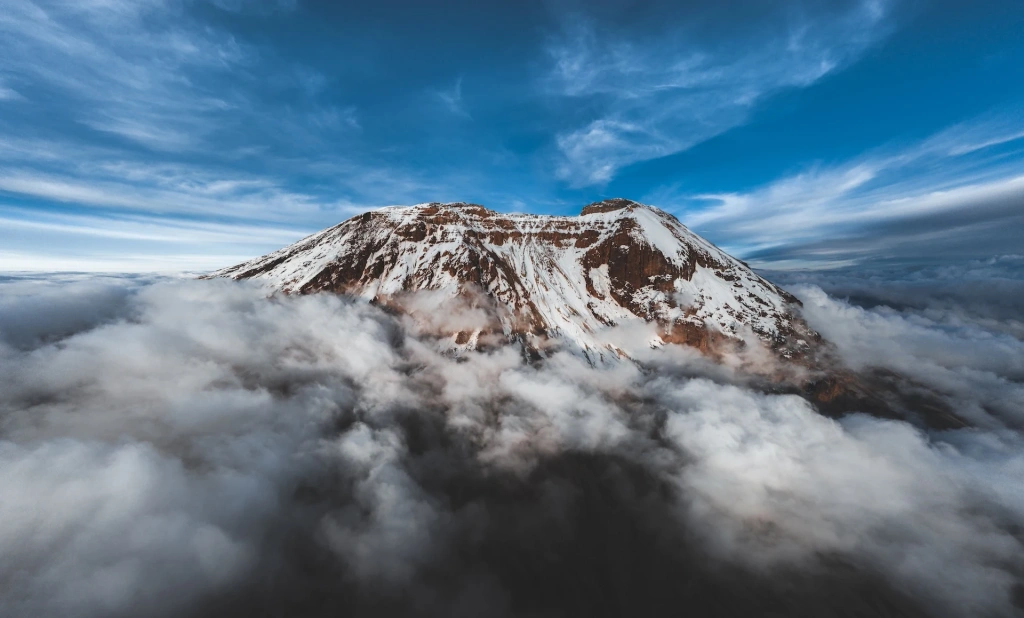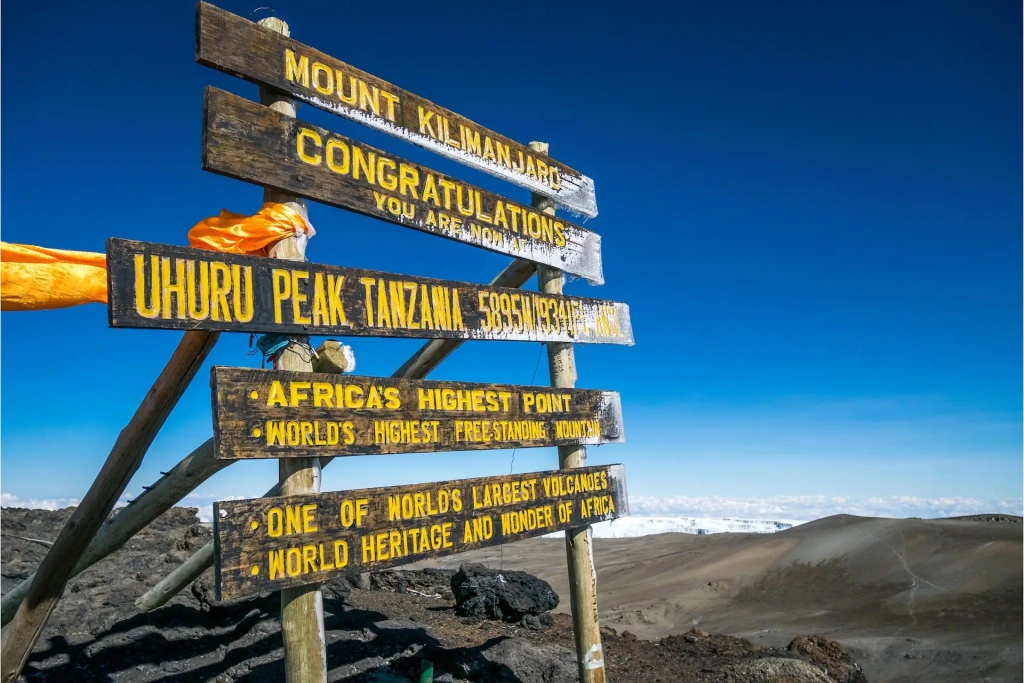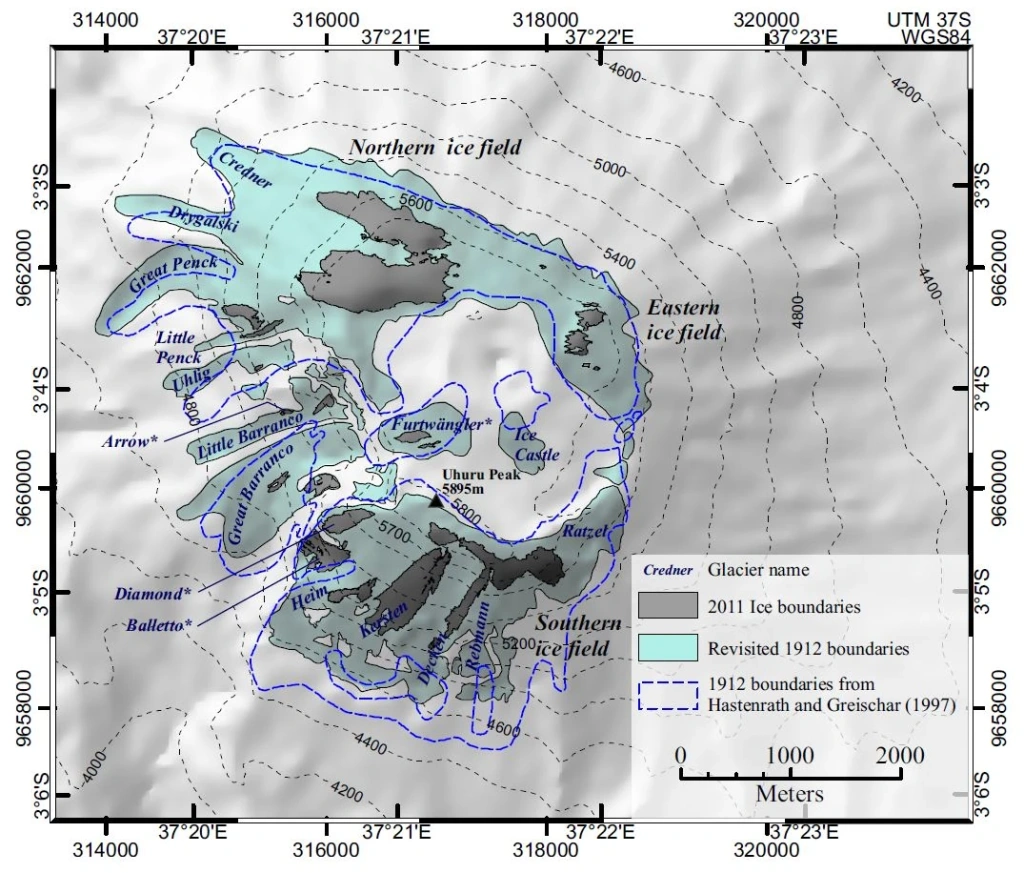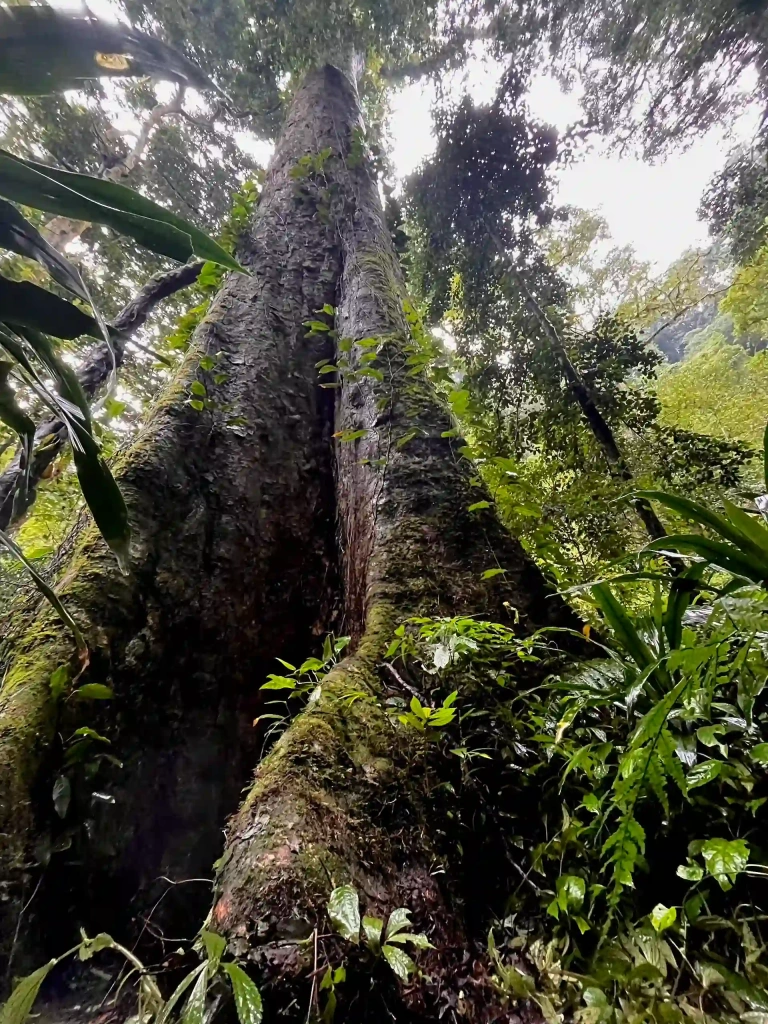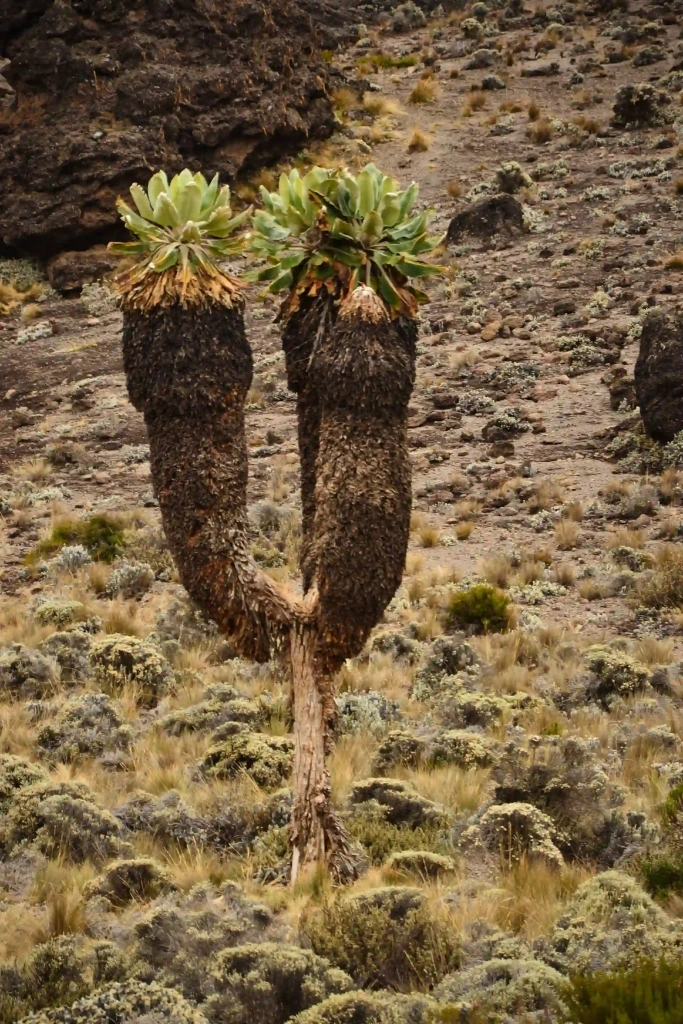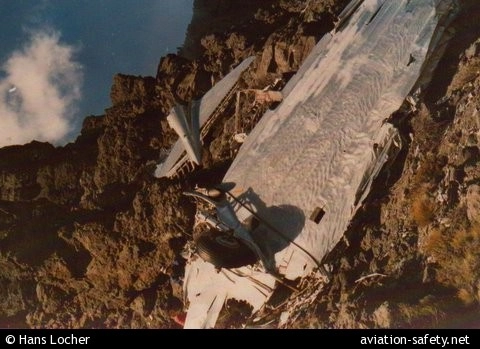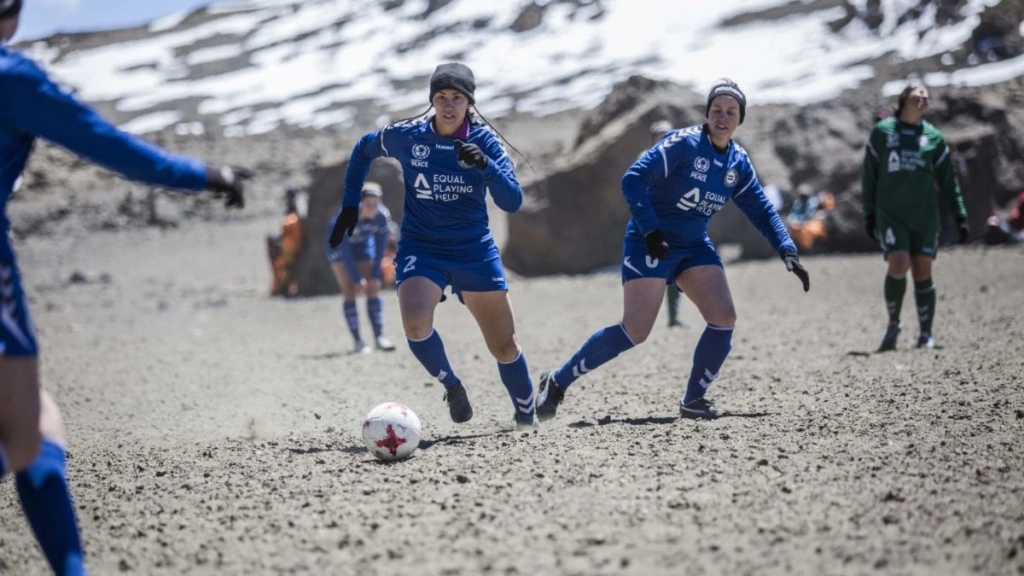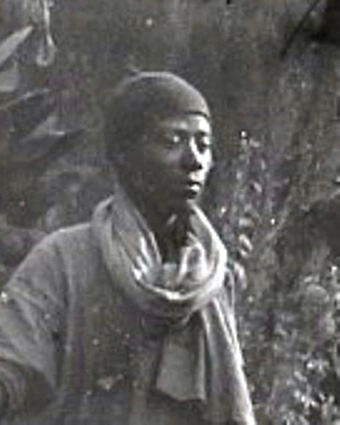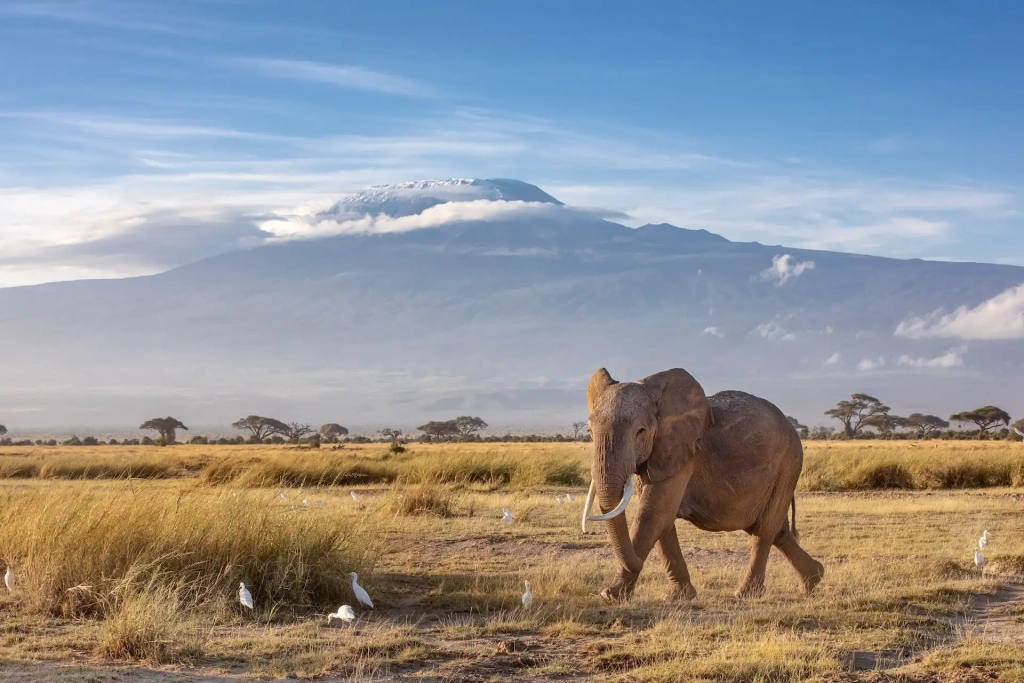Kilimanjaro, often called "The Roof of Africa," is the continent's tallest mountain and one of Africa's seven natural wonders. Many have heard about expeditions organized to climb Kilimanjaro. Interestingly, almost anyone can reach its summit without specialized mountaineering equipment. This tropical volcano is famous for its glaciers and snow-capped peaks, making it one of the few places in Africa where you can witness snowfall.
In previous blog posts, we've answered questions about where Kilimanjaro is located and what “the Roof of Africa” is known for. Now, we’ve compiled a digest of the most interesting facts about the continent's highest mountain.
1. Kilimanjaro is the highest freestanding mountain in the world, but there's a catch
Upon reaching Uhuru Peak, the highest point of Kilimanjaro, the proudly displayed sign says: "World’s highest free-standing mountain".
This means that Kilimanjaro, a record-breaking volcanic peak, stands isolated from other mountains by tens of miles and isn’t part of any mountain range. For example, you can’t say the same about Everest, which is part of the Himalayan mountain system, surrounded by many other peaks.
However, a closer examination of our planet's geography reveals that the true tallest freestanding mountain is actually Mauna Kea in Hawaii. Most of this giant is hidden beneath the waters of the Pacific Ocean, but if you measure its height from base to peak, you get an impressive figure of 10,205 meters (33,484 feet). This allows Mauna Kea to surpass Everest and be called the tallest mountain in the world.
Other volcanoes in the Hawaiian archipelago are located at a considerable distance, so Kilimanjaro can perhaps share the title of the highest freestanding mountain with Mauna Kea.
2. Kilimanjaro’s summit is farther from the Earth’s center than Everest’s summit
You can measure a mountain’s height from its base, the sea level, or the center of the Earth. When measured from the Earth’s center, Kilimanjaro's peak is farther away than Everest's summit. The same is true for some of the Andean mountains. This occurs because the Earth’s surface near the equator bulges farther into the atmosphere than at the poles, where the planet is slightly flattened.
Mount Everest's summit is (5,643 feet) closer to the Earth's center than Kilimanjaro's Uhuru Peak. In this regard, Kilimanjaro surpasses the tallest Himalayan mountain. However, "The Roof of Africa" is still not the highest—it falls short by 423 meters (1,388 feet) to Chimborazo in South America, whose peak extends the farthest into the atmosphere.
3. The fastest time to climb Kilimanjaro was only 4 hours and 56 minutes
The record for the fastest ascent to the summit of Kilimanjaro was set in 2014. The remarkable time was achieved by Swiss-Ecuadorian skyrunner Karl Egloff. To appreciate his impressive speed, compare it to the time it takes most people to conquer Africa's highest mountain. On average, it takes about 6 days, which is roughly 144 hours.
Kilimanjaro has seen many records. What’s the slowest ascent? How old was the oldest person to summit Kilimanjaro? Who was the first to parachute onto Kilimanjaro's peak? How long would it take to ascend Uhuru Peak backward? What type of pizza was once delivered to the "Roof of Africa"? You can read about these and other Kilimanjaro records in our blog.
4. Climbing Kilimanjaro is a journey from tropical rainforest to Arctic desert
Kilimanjaro is unique because this mountain, like a large cake with many layers, can be divided into several distinct climate zones. Although the mountain is near the equator, climbing to the summit often feels like a journey to the poles. Here’s why.
The climatic zones of Kilimanjaro and their features:
1. Cultivation zone: Once a forest, this area is now inhabited by people growing bananas, corn, coffee, and other crops. This zone extends up to 1,800 meters (5,906 feet) above sea level. It’s always warm here during the day, with temperatures rarely dropping below 20 °C (68 °F).
2. Rainforest Zone: Dense mountain forests on Kilimanjaro play a crucial role in the region's water cycle. Moisture-laden clouds from the Indian Ocean release rain as they pass over the forest, supporting a rich diversity of flora and fauna. However, this biodiversity is under threat due to human activities. Deforestation and habitat destruction are driving animals away, leading to a significant decline in wildlife. Once teeming with large animals like elephants, buffalo, and leopards, Kilimanjaro’s forest belt now mostly shelters smaller species. This forest zone spans approximately 1,000 meters (3,281 feet) in elevation, creating a warm and humid environment with daytime temperatures reaching up to 20 °C (68 °F).
3. Heath and Moorland Zone: Where the forest gradually ends, Afro-alpine heaths with shrub thickets and unique Kilimanjaro groundsels appear. It rains less here, so plants have adapted to store water. The air is humid, with frequent fogs and clouds drifting right along the ground. The temperature here is around 10°C (50°F). The moorlands extend from 2,800 to 4,000 meters (9,186 to 13,123 feet) above sea level.
4. Alpine Desert Zone: A rocky terrain where there are no plants anymore. Instead, stones are covered with mosses and lichens. Large animals rarely venture here, and there are noticeably fewer insects. Temperatures here approach 0 °C (32 °F). This zone ranges in height from 4,000 to 5,000 meters (13,123 to 16,404 feet) above sea level.
5. Arctic Summit Zone: The final stretch of the journey up Kilimanjaro is a challenging ascent, where snow falls during the rainy seasons and can linger for extended periods, sometimes accumulating in significant amounts. For centuries, the summit of Kilimanjaro has been home to glaciers, with massive ice formations covering the mountain's highest elevations above 5,000 meters (16,404 feet). Temperatures here plummet to -15 to -20 °C (5 to -4 °F) or even lower, creating an arctic desert on the "Roof of Africa." This is where the natural wonder of "eternal" ice exists, remarkably close to the equator.
5. Kilimanjaro's glaciers may disappear by 2050
The current ice formations at the summit of Kilimanjaro are remnants of ancient glaciers that have covered the mountain for thousands of years. Since people first discovered the African mountain with ice and documented its condition, there has been a rapid retreat of the ice fields. At the beginning of the 20th century, the ice covered 12 square kilometers (4.6 square miles); now it’s about 2 square kilometers (0.8 square miles).
So, what’s happening to the glaciers, and why are they shrinking and disappearing? The main reasons are global temperature increases and significant reductions in precipitation. The latter is largely due to deforestation on Kilimanjaro’s slopes. The forests play an active role in the mountain’s water circulation. Glaciers are constantly transforming. On Kilimanjaro, they melt from the bottom and from other sides. However, snowfall adds new layers on top that melt and compact. Unfortunately, this process has slowed down in recent decades. The ice is decreasing much faster than it’s accumulating.
Some glaciers have already disappeared. Those once photographed and sketched by travelers in the 20th century now exist only in photos and old maps. If the current trends continue, we may see the complete disappearance of these glaciers within the next 20–30 years.
Those climbing Kilimanjaro today still have the chance to witness the ice giants of this volcano, designated as a UNESCO World Heritage Site.
6. The tallest tree in Africa grows on Kilimanjaro
It’s an interesting coincidence that the tallest tree in Africa was discovered on the slopes of the continent's highest mountain. This discovery was made relatively recently, in 2016. The scientific name of the species is Entandrophragma excelsum. This particular record-holding tree stands at 81.5 meters (267 feet) tall.
This enormous tree grows on the southern slopes of Kilimanjaro, and a trail leads right to it, making it accessible for anyone who wants to visit. You can read more about our trip to Africa's tallest tree.
7. Dendrosenecio kilimanjari—an amazing endemic plant found only on Kilimanjaro
Another fascinating plant found on Kilimanjaro is the Kilimanjaro Groundsel (Dendrosenecio kilimanjari), which has a distinctive candelabra-like shape. These plants dot the afro-alpine meadows of the volcano, standing out with their tree-like forms that reach up to 5 meters (16 feet), with some even growing as tall as 10 meters (33 feet).
One of the most intriguing aspects of these plants is their large leaves, which open during the day to capture sunlight and then fold up at night to protect the crowns from the cold. The leaves also collect water, which the plant stores like a succulent, helping it survive in the dry zone. Another unique feature is that senecios don’t shed their old, dried leaves but instead use them to insulate their tall stems.
Dendrosenecio kilimanjari are long-lived plants, with an average lifespan of 100 to 200 years. Their slow growth rate, about 3 to 5 centimeters (1.2 to 2 inches) per year, along with their ability to heal injuries, contributes to their longevity.
8. Kilimanjaro National Park is home to several endemic plants and animals
In addition to the Kilimanjaro groundsel, the mountain is home to other plants that can’t be found anywhere else in the world. One of the most recognizable is the Kilimanjaro Impatiens, a small plant with delicate flowers. If you touch its seed pod, it will burst, shooting seeds far away.
Other examples include the Kilimanjaro Everlasting and the Giant Lobelia. The Everlasting is named for its ability to survive at high altitudes in the dry heath zone. It creeps along the rocks of the Shira Plateau, adding a splash of color to the otherwise barren landscape. The Lobelia stands out with its enormous flower spikes, which can reach up to 4 meters (13 feet) in height, towering over the rocky slopes.
Among the endemic animals of the mountain, perhaps the most interesting is the beautiful olive-yellow bird, the Kilimanjaro White-eye. Although there are related species of white-eyes, identifying this endemic species can be tricky. The Kilimanjaro White-eye is distinguished by the large width of its white ring.
Other animals found on Kilimanjaro include the Delectable soft-furred mouse (Montemys delectorum), Kilimanjaro shrew (Crocidura monax), and Mount Kilimanjaro vlei rat (Otomys zinki). Although these rodents are frequently spotted on the mountain, there isn’t much scientific information available about them. The most elusive of Kilimanjaro's endemics is a frog species called Strongylopus kilimanjaro, last observed by scientists in 1936.
Another rare animal on Kilimanjaro is a Tanzanian forest antelope known as Abbott's Duiker. The first photograph of this species was published by scientists only in 2005. Recently, the Altezza Travel team was fortunate to capture it on a camera trap set in the Kilimanjaro forest. You can read more about this rare find in our article on the elusive Abbott's Duiker.
9. A plane once crashed into Kilimanjaro, marking the worst aviation disaster in Tanzanian history
In May 1955, a passenger plane, the Douglas DC-3, was flying over what was then called Tanganyika (now Tanzania). It was en route from Dar es Salaam to Nairobi with 16 passengers and four crew members on board. Due to heavy cloud cover, the pilots were flying partially by instruments. They failed to notice the eastern peak of Kilimanjaro hidden in the clouds, and the plane crashed into the rocky mountain, exploding upon impact. A search operation launched four days later found the wreckage scattered across the mountainside, along with the bodies of the passengers and crew. Tragically, all 20 people on board died.
The wreckage can still be seen today on the southeastern side of Kilimanjaro, on the slopes of Mawenzi volcano. Expeditions to this area are rare, so few climbers have visited the crash site. The bodies of the victims remain unburied, as neither the initial search operation nor a second one nine years later could recover them. The high altitude and challenging terrain have kept this somber location largely untouched by visitors.
There have been other aviation accidents on Kilimanjaro, including cases where the details remain uncertain due to the disappearance of planes. We discuss these incidents in our article about deaths on Mount Kilimanjaro.
10. Kilimanjaro doesn’t “rise like Olympus above the Serengeti”
In the popular song "Africa" by the American band Toto, the lyrics state that "Kilimanjaro rises like Olympus above the Serengeti." While this is a beautiful poetic comparison, it doesn’t align with geographical facts. The Serengeti plain is at least 230 kilometers (143 miles) away from Mount Kilimanjaro in a straight line, making the comparison to Olympus somewhat misleading. Additionally, it's unclear which "Olympus" the song refers to—whether it's the Greek mountain, which stands at less than 3,000 meters (9,843 feet), the Martian volcano over 20 kilometers (12.4 miles) high, or the mythical home of the gods.
Besides the distance, the terrain between them also obscures the view, with other mountains and hills in the way. Even with perfect weather and a clear sky, detailed calculations show that Kilimanjaro would not be visible from the Serengeti, even with good optics. So, the idea of the mountain dominating the plain where the Great Wildebeest Migration takes place is purely a lyrical invention.
Despite the factual inaccuracies, the song remains a classic. You can find online analyses of the lyrics, which include critiques of the band’s pronunciation of "Serengeti" and the poetic liberties taken. But we still love the song, and it’s important to remember that it’s a work of art. After all, the musicians hadn’t been to Africa before writing the hit, so these mistakes are forgivable.
11. Kilimanjaro is a volcano, and it might erupt again
Not everyone knows that the highest mountain in Africa is classified as a stratovolcano. It has three volcanic cones: Shira, Mawenzi, and Kibo. Since they formed hundreds of thousands of years apart, it’s accurate to say that this mountain massif consists of three volcanoes. While Shira and Mawenzi have long since ceased their activity, the youngest volcano, Kibo, is technically not extinct. It is classified as dormant, although the last eruption occurred no less than 150,000 years ago.
What are the chances of Kibo becoming active again? They’re incredibly slim. This is evident from the glaciers that have been lying on Kibo for thousands of years. However, beneath the surface of the crater, temperatures remain quite high. In the 2000s, German scientists from the University of Bayreuth conducted studies that confirmed deep-seated activity on Kilimanjaro. A few meters below the surface, temperatures can reach 80–100 °C (176–212 °F). At a depth of 100 meters (328 feet), the temperature is estimated to be around 600 °C (1,112 °F).
12. The highest-altitude football match on the planet took place in Kilimanjaro crater
In 2017, a real football match was held in the crater of Kibo volcano. The playing field was marked with flour, trekking poles were used instead of corner flags, and the athletes played two standard halves, kicking a ball across the volcanic dust. Representatives from the Guinness World Records recorded the altitude at 5,714 meters (18,746 feet) above sea level. Interestingly, all the players were women.
The temperature in the crater of Kilimanjaro, which is one of the Seven Summits, ranges from 0 to -20 °C (32 to -4 °F). Another challenge for the athletes was the altitude. Acclimatization at high altitudes is difficult, and intense physical activity doesn’t make it any easier to deal with altitude sickness. All this makes their record especially impressive.
13. Today, more than 50,000 people climb Kilimanjaro every year. The first was Hans Meyer in 1889.
In recent years, the popularity of climbing Kilimanjaro has soared. While in the 2000s, the number of climbers ranged between 20,000 and 40,000 annually, it now exceeds 60,000 in some years. If you’re thinking about climbing the "Roof of Africa," join one of the many group expeditions to its summit.
But here’s how it all started. In the late 1840s, German explorer Johannes Rebmann discovered Kilimanjaro and attempted to climb it. Over the next 40 years, other explorers in East Africa made several attempts to reach the summit, fighting with the elements and acute mountain sickness, but none succeeded. At that time, the amount of ice and snow made it physically challenging to ascend.
Finally, on October 6, 1889, German explorer Hans Meyer became the first person to reach the summit of Kilimanjaro. He was accompanied by professional mountaineer Ludwig Purtscheller. Almost to the glaciers, they were escorted by a local guide named Muini Amani, whose contribution is sadly almost forgotten by history. Today, the first successful ascent by a native Tanzanian is attributed to a man named Yohani Lauwo, but this is a historical mistake.
14. Uhuru Peak used to have a different name, as did the early camps on the way to the summit.
Today, Kilimanjaro's highest point is known as Uhuru Peak, but this wasn’t always the case. Before 1962, it was called Kaiser Wilhelm Peak, named after the last emperor of Germany, Wilhelm II. The peak was so named by the first successful climber, German Hans Meyer. The name was changed to Uhuru Peak after Tanganyika gained independence. "Uhuru" means "freedom" in Swahili.
In the same year, two of the lower camps on the historic first route, Marangu, were also renamed. Bismarck Hut became Mandara Hut, named after the head of one of the local clans. The Tanzanians removed the name of German Chancellor Otto von Bismarck to erase the memory of colonial dependency on Germany. This sentiment was even more strongly reflected in the renaming of Peters Hut to Horombo Hut. Horombo was the name of another local clan leader. Meanwhile, Carl Peters, for whom the original hut was named, was a German colonial administrator known for his racist and brutal treatment of the local population. Erasing his memory was a point of pride for the residents of the Kilimanjaro villages.
15. The meaning of the word “Kilimanjaro” is still debated
The most popular theory about the origin of the name Kilimanjaro breaks it down into two words: kilima and njaro. The first word traces back to the Swahili for "mountain, hill," and the second to the Maasai for "water, source." This version is justified since Kilimanjaro is the source of all the region’s major rivers, which descend the hills and run through the plains of Tanzania and Kenya to the Indian Ocean.
Another popular version translates the name Kilimanjaro as "Shining Mountain" or "White Mountain." In this case, it refers to the snow-covered summit, which indeed shines in the sun on clear days. However, this version requires some linguistic manipulation, slightly altering the original pronunciation of the mountain’s name.
There are more complex theories involving the languages of other peoples living near Kilimanjaro. We discuss all the theories in our article on the riddle of Kilimanjaro’s name. However, the mystery remains, and all the proposed versions are merely the assumptions of past explorers and modern linguists.
16. Kilimanjaro is often photographed from Kenya, but you can only climb it from Tanzania
One of the most interesting facts about Kilimanjaro, one of the Natural World Heritage Sites, is that it’s known worldwide through images taken from Kenya. Most of the most beautiful photos are shot from Amboseli National Park. This can be explained by several factors:
- On the northern, Kenyan side, there’s no forest to obscure the mountain’s base as there is on the southern, Tanzanian side.
- More glaciers and snow are visible from Kilimanjaro's northern side.
- The plains at the northern base are flat, open, and less populated than the southern base, where the Chagga people traditionally live under the forest cover.
- In Amboseli Park, giraffes and elephants roam, creating a stunning scene with these large African animals against the backdrop of the majestic mountain.
However, if you want to climb this famous peak included in the Seven Summits list, you’ll need to travel to Tanzania, specifically to the southern base of Kilimanjaro, where nearly all climbing routes begin. There is one northern route, but it also starts in Tanzania. From Kenya, you can only admire the mountain from a distance.
Ready to embark on your own Kilimanjaro climb? Join the Altezza Travel team and let’s explore Africa's tallest mountain together. Discover the beauty, history, and wonder of Kilimanjaro firsthand!
All content on Altezza Travel is created with expert insights and thorough research, in line with our Editorial Policy.
Want to know more about Tanzania adventures?
Get in touch with our team! We've explored all the top destinations across Tanzania. Our Kilimanjaro-based adventure consultants are ready to share tips and help you plan your unforgettable journey.















